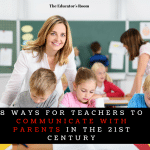 Each year we get a new group of students and they bring along parents. We have opportunities at the beginning of the year to set up a relationship here that can work towards learning or against learning. There are a few simple things you can do as you start the school year to invite parents into your classroom and open communication.
Each year we get a new group of students and they bring along parents. We have opportunities at the beginning of the year to set up a relationship here that can work towards learning or against learning. There are a few simple things you can do as you start the school year to invite parents into your classroom and open communication.
1. Watch Your Language. As educators we are immersed in the vocabulary and acronyms of education. We understand our curriculum and strategies we use in our classrooms for mathematics and reading education. Parents do not know this vocabulary. They don’t know these strategies. When sharing information be mindful of how you are talking, watch your language. Don’t rely on “teacher” words and phrases; give parents specific information that is meaningful in their language. Just as you write your objectives in kid friendly language, remember to share information and expectations in parent friendly language. “Rigor,” “Common Core,” “Multiplication Strategies,” “Comprehension Strategies,” “Fluency” …the list goes on. As you prepare your blogs, newsletters, and information for Back to School Night think from a parent point of view. We put parents on the offensive by making them feel confused and lost in the beginning. Bridge the gap and explain in friendly terms what you want them to know.
2. Introduce Yourself! Parents are the experts on their child. They have been with them through the journey thus far and we are a small step in the path. Open the communication pathway with a warm introduction. Provide them with a business card, magnet, email, or post card that includes your contact information and the best time of day to reach you. When parents know you value their opinion, they become part of the team. You are both working toward the same goal: the education of their child. Give a warm smile and extend a friendly hand when you introduce yourself to your new families.
3. Keep it Positive. Studies show you need 5:1, or up to as many as 15:1, positive comments to outweigh a negative comment. In the beginning of the year: stock up. Send home little notes, messages or emails about positive behaviors. Make sure they are meaningful (don’t compliment breathing) but find small things each student does and jot a note. Here is a list of 100 positive comments that can be personalized and sent home in agendas or on small notes. They will set a positive communication path so down the road when not-so-positive issues arise, parents will have already seen you have the best interest of their child in mind. Being positive is an important step in the beginning of the year process.
My children are extensions of myself. I want what is best for them and know each of their individual needs and personalities well. Each year when I send them to school I hold my breath to see what their teacher is like. I want this environment to be warm and nurturing. I want it to be everything they need. Our role as teachers is to open the communication lines so we can provide this for every student in our room. Watch your language this fall so you bring families, not just students, into your room for a rewarding and meaningful year.





Leave a comment